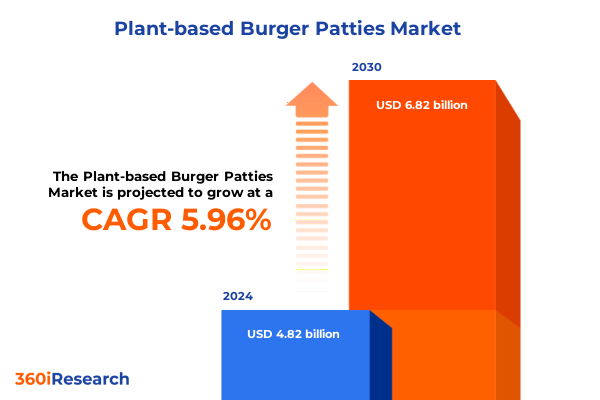The Plant-based Burger Patties Market size was estimated at USD 4.82 billion in 2024 and expected to reach USD 5.11 billion in 2025, at a CAGR 5.96% to reach USD 6.82 billion by 2030.

Introduction to the Plant-Based Burger Patty Sector
The plant-based burger patty market has evolved from a niche alternative to a mainstream staple over the past decade. Fueled by rising consumer interest in health, sustainability, and ethical sourcing, manufacturers have rapidly expanded their portfolios to meet demand across diverse demographics. This executive summary distills the key trends, shifts, and strategic imperatives shaping the competitive landscape. It frames how innovation in ingredients, textures, and distribution channels is driving product differentiation, and how evolving consumer preferences-spanning flexitarians to dedicated vegan and vegetarian segments-are reshaping purchase behavior. Through a concise exploration of recent policy changes, tariff developments, segmentation insights, and regional dynamics, this introduction sets the stage for a deeper dive into the forces redefining growth opportunities and competitive advantage within the plant-based burger patty sector.
Transformative Shifts Redefining the Plant-Based Burger Landscape
The plant-based burger category is in the midst of transformative shifts as technological breakthroughs, consumer values, and regulatory landscapes converge. Novel protein sources, including precision fermentation and hybrid formulations, are challenging traditional pea- and soy-based offerings. Clean-label expectations are accelerating investment in recognizable binders such as arrowroot flour, chia seed, and flaxseed, while premium flavorings-ranging from proprietary spice blends to natural extracts-are creating artisanal profiles. Texture innovation now spans chunky, meat-like, and smooth experiences, catering to beany and nutty enthusiasts as well as those seeking firm, juicy, or creamy mouthfeel.
Simultaneously, distribution channels have evolved beyond conventional supermarket aisles. E-commerce giants and niche plant-based platforms deliver direct-to-consumer subscription boxes, while gourmet grocers and vegan stores curate specialty lines. Fast-food chains and casual dining venues are embedding patties into core menus, raising consumer exposure and driving trial. This landscape shift underscores the need for agile supply chains that can support rapid scale-up and customization-a hallmark of leaders who are harnessing data-driven insights to anticipate regional and demographic preferences.
Assessing the Cumulative Impact of U.S. Tariffs in 2025
The implementation of new United States tariffs in 2025 has introduced both challenges and opportunities for importers and domestic producers. While higher duties on certain plant protein imports have increased raw material costs for pea protein and rice protein, domestic pea growers have benefited from heightened local sourcing demand. Manufacturers that pivoted early to secure long-term supply contracts mitigated cost volatility and protected margins. At the same time, price-sensitive product tiers experienced margin compression, prompting some brands to adjust pack sizes or reformulate using cost-efficient binders and flavorings.
Parallel policies aimed at incentivizing domestic processing have spurred capital investments in plant protein extraction facilities, creating regional hubs that benefit from economies of scale. These developments have elevated the importance of integrated supply chain strategies, where vertical partnerships between protein suppliers, co-manufacturers, and distribution platforms ensure reliability in an uncertain trade environment. As tariffs continue to influence raw material sourcing decisions, agile procurement teams and proactive hedging strategies have become critical levers for sustaining product affordability and competitive positioning.
Key Insights from Market Segmentation Analysis
A granular analysis of the market’s segmentation reveals differentiated growth pockets and innovation hotspots. Based on product type, black bean burgers-offered in mildly spicy and southwestern style-are resonating with value-focused consumers seeking bold flavor, while chickpea burgers in Mediterranean style and spiced variants are capturing interest from those prioritizing exotic taste profiles. Classic burgers formulated with soy-based, tempeh-based, and veef alternatives maintain their position as entry-level options, whereas portobello and shiitake mushroom burgers appeal to premium niches craving gourmet authenticity.
When examined through the lens of ingredients, binders such as arrowroot flour, chia seed, and flaxseed are redefining texture and clean-label appeal. Flavoring innovations span artificial flavors, natural flavors, and bespoke blends of spices and herbs. Protein sources have diversified: pea protein leads mainstream adoption, rice protein and soy protein support mid-tier offerings, and wheat protein-commonly seitan-drives niche, high-protein variants. Distribution channels further illustrate market dynamics: casual dining and fast-food chains introduce patties to mass audiences, while e-commerce giants and niche plant-based platforms champion direct-to-consumer models. Gourmet grocers and vegan stores curate specialty assortments, and mainstream supermarket chains alongside organic and health-focused outlets cater to both broad and wellness-driven shopper segments.
End user demographics inform targeted marketing: adults and seniors appreciate familiar formats with health benefits, teen and young adult cohorts seek adventurous flavors and social media-worthy experiences, flexitarians balance plant-based choices with occasional meat, health-oriented purchasers scrutinize nutritional profiles, and vegan or vegetarian consumers demand certification alignment. Certifications and claims-such as gluten-free certified, halal certified, kosher certified, non-GMO verified, and organic certification-serve as trust signals. Finally, textural preferences span the spectrum from chunky beany or nutty experiences to firm and juicy meat-like textures, and creamy or soft smooth offerings, underscoring the critical role of mouthfeel in consumer acceptance.
This comprehensive research report categorizes the Plant-based Burger Patties market into clearly defined segments, providing a detailed analysis of emerging trends and precise revenue forecasts to support strategic decision-making.
- Product Type
- Ingredients
- Distribution Channel
- End User Demographics
- Certifications & Claims
- Texture
Regional Dynamics Shaping Global Plant-Based Burger Growth
Regional dynamics reveal that the Americas continue to drive volume, propelled by widespread retail penetration and aggressive marketing campaigns from established players. Heightened consumer awareness of environmental impact and animal welfare is elevating premium priced offerings in urban centers. In Europe, the Middle East & Africa, regulatory alignment on plant-based product labeling and protein-content mandates has favored transparent ingredient declarations, while local producers in the Middle East are exploring chickpea and lentil-based formulations to leverage regional agricultural strengths. Africa’s emerging markets are characterized by small-scale production models with opportunities to scale through cooperative frameworks.
The Asia-Pacific region exhibits divergent patterns: urban markets in Japan, South Korea, and Australia demonstrate strong appetite for meat-like textures and gourmet variations, whereas Southeast Asian economies prioritize cost-effective binders and locally sourced proteins such as mung bean. Rapid growth in foodservice channels-especially in fast-food chains introducing plant-based options-augurs well for category expansion. Cross-border e-commerce is also opening channels for specialty brands to introduce exotic flavor variants and certification-endorsed products, amplifying competitive dynamics across regions.
This comprehensive research report examines key regions that drive the evolution of the Plant-based Burger Patties market, offering deep insights into regional trends, growth factors, and industry developments that are influencing market performance.
- Americas
- Asia-Pacific
- Europe, Middle East & Africa
Strategic Profiles of Leading Market Participants
Industry leaders are harnessing distinct strategic approaches to maintain momentum. Alpha Foods, Inc. and Atlantic Natural Foods focus on rapid portfolio expansion through acquisitions and co-manufacturing partnerships, while Beyond Meat Inc. and Impossible Foods Inc. invest heavily in R&D to improve protein quality and flavor authenticity. Conagra Brands Inc. leverages its extensive distribution network to bring competitively priced offerings to mainstream supermarkets, and Hilary’s Drink Eat Well LLC differentiates with allergen-friendly, organic-certified recipes. Hungry Planet Inc. emphasizes local production and co-branding with foodservice operators, whereas Kroger Company uses private-label innovation to capture value-seeking shoppers.
Global conglomerates such as Nestle SA, Unilever Plc, and The Kraft Heinz Company balance scale economies with targeted brand incubators. Maple Leaf Foods Inc. and Tyson Foods Inc. explore hybrid meat–plant formulations, capitalizing on existing channels and consumer trust. Tesco Plc and The Kellogg’s Company engage in retail–supplier collaborations to support sustainable sourcing, and The Tofurky Co. Inc. and Transcend Information Inc. appeal to niche vegan communities through robust certification credentials and community-driven marketing initiatives.
This comprehensive research report delivers an in-depth overview of the principal market players in the Plant-based Burger Patties market, evaluating their market share, strategic initiatives, and competitive positioning to illuminate the factors shaping the competitive landscape.
- Alpha Foods, Inc.
- Atlantic Natural Foods
- Beyond Meat Inc.
- Conagra Brands Inc.
- Hilary’s Drink Eat Well LLC
- Hungry Planet Inc.
- Impossible Foods Inc.
- Kroger Company
- Maple Leaf Foods Inc.
- Nestle SA
- Tesco Plc
- The Kellogg's Company
- The Kraft Heinz Company
- The Tofurky Co. Inc.
- Transcend Information Inc.
- Tyson Foods Inc.
- Unilever Plc
Actionable Recommendations to Drive Competitive Advantage
To capitalize on evolving market dynamics, industry leaders should adopt a multi-pronged approach. First, deepen investment in next-generation proteins and precision fermentation to stay ahead of texture and flavor benchmarks. Second, diversify product portfolios across value, mid, and premium tiers by leveraging cost-efficient binders and tiered flavor systems. Third, strengthen supply chain resilience through strategic sourcing partnerships and long-term agreements to hedge against tariff volatility and ingredient scarcity.
Fourth, expand distribution footprints by aligning with both mainstream supermarket chains and niche e-commerce platforms, while forging co-marketing initiatives with fast-food and casual dining operators to drive on-menu trials. Fifth, elevate brand trust through rigorous certification and transparent labeling, addressing allergen, halal, kosher, and clean-label demands. Sixth, tailor regional strategies by customizing formulations-for example, emphasizing chickpea and lentil bases in the Middle East and mung bean protein in Southeast Asia-to capture local taste preferences and regulatory advantages. Finally, deploy digital consumer engagement-utilizing social media influencers, community forums, and subscription models-to gather real-time feedback and foster brand loyalty.
Explore AI-driven insights for the Plant-based Burger Patties market with ResearchAI on our online platform, providing deeper, data-backed market analysis.
Ask ResearchAI anything
World's First Innovative Al for Market Research
Concluding Perspectives on Market Evolution
The plant-based burger patty market stands at a pivotal inflection point, shaped by relentless innovation, shifting trade policies, and dynamic consumer cohorts. Brands that align product development with emerging textural benchmarks and clean-label mandates will excel, as will those that integrate agile procurement practices in response to tariff fluctuations. Strategic segmentation and localization will unlock growth, while partnerships across the supply chain and distribution network will ensure both scale and adaptability.
Looking ahead, the winners will be those who invest in both technological advancement and consumer-centric storytelling-harnessing authenticity, nutrition, and sustainability narratives to resonate with diverse audiences. By balancing global best practices with regional customization, market participants can capture the full spectrum of opportunity and secure long-term leadership in a rapidly expanding category.
This section provides a structured overview of the report, outlining key chapters and topics covered for easy reference in our Plant-based Burger Patties market comprehensive research report.
- Preface
- Research Methodology
- Executive Summary
- Market Overview
- Market Dynamics
- Market Insights
- Cumulative Impact of United States Tariffs 2025
- Plant-based Burger Patties Market, by Product Type
- Plant-based Burger Patties Market, by Ingredients
- Plant-based Burger Patties Market, by Distribution Channel
- Plant-based Burger Patties Market, by End User Demographics
- Plant-based Burger Patties Market, by Certifications & Claims
- Plant-based Burger Patties Market, by Texture
- Americas Plant-based Burger Patties Market
- Asia-Pacific Plant-based Burger Patties Market
- Europe, Middle East & Africa Plant-based Burger Patties Market
- Competitive Landscape
- ResearchAI
- ResearchStatistics
- ResearchContacts
- ResearchArticles
- Appendix
- List of Figures [Total: 28]
- List of Tables [Total: 995 ]
Connect with Ketan Rohom to Access the Full Research Report
To explore the full breadth of insights, data, and strategic analysis within the comprehensive market research report, connect directly with Ketan Rohom, Associate Director of Sales & Marketing, to secure your copy and gain a decisive competitive edge.

- How big is the Plant-based Burger Patties Market?
- What is the Plant-based Burger Patties Market growth?
- When do I get the report?
- In what format does this report get delivered to me?
- How long has 360iResearch been around?
- What if I have a question about your reports?
- Can I share this report with my team?
- Can I use your research in my presentation?




